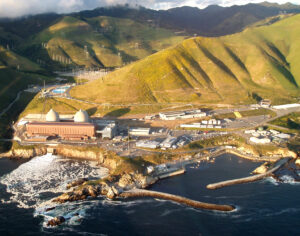
The question has surfaced as the conversation around Diablo Canyon shifts toward action.
While chatter has been bubbling for months, state- and federal-level efforts are now actively exploring pathways to keep the plant running past its planned closure.
Ensuring that Diablo Canyon continues to be an economic engine for the region has been a key REACH priority from the very start. Since our founding three years ago, that has meant helping plan for the 2024/25 decommissioning and future reuse of the plant.
But as the state grapples with the grim alternatives of power shortages or increasing carbon-emitting coal and gas usage, more and more eyes have been looking toward Diablo, the state’s largest single source of energy.
Where we stand: In this fast-evolving situation, REACH is pressing for clarity and collaboration around a short-, mid- and long-term roadmap for Diablo Canyon so that it can continue to play a leading role in our region’s economy and our state’s energy ecosystem.
“Charting the future of this site raises complex questions as well as unique opportunities for our region, state and country to collaborate to advance clean energy innovation,” states the letter we sent to Gov. Newsom and a dozen other state and federal officials on Tuesday.
Also vital is conserving the plant’s surrounding 12,000 acres, which hold cultural, tribal and ecological significance, as soon as feasible and independent of plant operations.
The big picture: With the right pieces in place, a short-term extension for Diablo could provide a bridge to reaching the state’s clean-energy goals and deliver a triple win for the state, the environment and our region. Such a path could:
-
Bring stability to the state’s energy supply without increasing carbon emissions while the long-term renewable portfolio is built out, including offshore wind energy off Morro Bay that is estimated to come online around 2030
-
Provide resources, planning and partnership toward our community vision for a clean-tech innovation park as Diablo’s next chapter
-
Extend the plant’s jobs and economic impacts as the clean-tech park and other opportunities are built out
The fine print: As usual, the devil is in the details. A host of complex policy, regulatory, technical and logistical issues need to be worked out as part of any plan to keep the plant operating. And it remains unclear how the state envisions any short-term changes fitting within a broader roadmap that builds towards a renewables future. REACH is engaging with a range of state and federal officials to ensure that the region is included in the decision-making process and that our interests and long-term economic stability are taken into account.
The latest + what’s next: The Biden Administration on Friday proposed changes requested by Newsom to allow Diablo Canyon to qualify for federal financial assistance to continue operating. The deadline for Diablo’s operator, PG&E, to apply for funding has been extended until July 5. Meanwhile, state-level action to allow the plant’s extended operation could come up in the legislature as early as this week or next.
What they’re saying:
-
“Climate change is causing unprecedented stress on California’s energy system,” Newsom’s office wrote in seeking changes to the federal Civil Nuclear Credit Program. “To maximize options to maintain electricity reliability as new projects come online, the state is evaluating a temporary delay of the planned retirement of DCPP.”
- “While California is leading the way on renewables, we aren’t there yet,” U.S. Sen. Dianne Feinstein wrote in an op-ed on why she now supports keeping the plant running until the state can replace its production with clean sources.
- “The Central Coast will become the clean energy capital of the US if we all work together,” Assemblyman Jordan Cunningham tweeted.